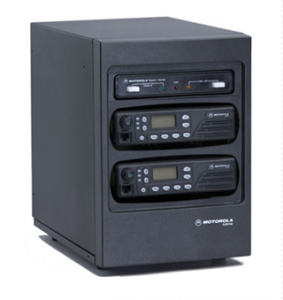 Third in a series
Third in a series
Base stations and repeaters add enormous power and flexibility to a two-way radio network. They also can add considerable expense and complexity. That’s why a lot of organizations choose to
rent base stations and repeaters rather than
buy them. You don’t have to bear the full cost of the equipment, and your dealer can be an enormous asset with the technical details.
When you acquire a fleet of radios and turn your people loose
on them, unforeseen problems start cropping up:
- People find themselves out of radio range in an emergency.
- Trees, buildings and hills block critical transmissions.
- Nobody seems to be in charge of the radio network, creating communications chaos.
Repeaters and base stations address these issues.
What exactly does a repeater do?
A repeater is a radio that transmits and receives RF signals. It receives signals from radios and transmits them to other radios.
Imagine it’s your job to coordinate the communications of a Formula One racing event. Track officials need to be in constant communication in case of an accident, but they often have a serious challenge if the race goes through the middle of a big city: There’s a huge building standing between them.
The solution is to install a repeater connected to an antenna on the top of that building. All the officials’ calls are routed up to the repeater’s antenna and back down to their colleagues. The repeater has a lot more power and channel capacity than a handheld radio, so it can keep everybody connected over a far wider area than a network of portable radios.
What does a base station do?
A base station allows an organization to coordinate radio communications at a single site. Base stations are perfect for companies that have fleets of vehicles, but any radio network with large numbers of people who need to be supervised or coordinated probably should have a base station.
Base station radios have powerful transmitters that send signals out over a vast area. They also have complex circuitry to handle sending and receiving over a large number of channels with a large group of users.
A
trunking base station is even more complex. It combines transmission power with computer software to create user groups who can talk only to each other.
Trunking also allows far more people to talk
on a radio network than would be possible with a conventional system because the software can automatically reroute calls to any available frequency.
What are the key issues with renting base stations and repeaters?
Complexity is the greatest challenge. Every repeater has to be programmed with two frequencies for every channel it will use, and every portable radio has to be configured to communicate with all repeaters and base stations. Your dealer can handle all the programming, but you still have to be aware of all those functions to be able to troubleshoot the system once it’s up and running.
You need access to an antenna. You probably would not want to install a tower in a rental scenario. You may be able to rent antenna capacity from people who already have one installed. Again, this is an issue to iron out with your dealer.
You may want a digital/analog hybrid.
Motorola Solutions repeaters illustrate why this is a good idea. They can automatically switch back and forth between digital and analog signals, a great option if you need the security of digital encryption for some of your radios, but not all of them. A digital/analog hybrid system also can use data functions such as GPS and telemetry.
Somebody has to staff the base station. Make sure you set aside time and resources to train a person for this job.
 Third in a series
Base stations and repeaters add enormous power and flexibility to a two-way radio network. They also can add considerable expense and complexity. That’s why a lot of organizations choose to rent base stations and repeaters rather than buy them. You don’t have to bear the full cost of the equipment, and your dealer can be an enormous asset with the technical details.
When you acquire a fleet of radios and turn your people loose on them, unforeseen problems start cropping up:
Third in a series
Base stations and repeaters add enormous power and flexibility to a two-way radio network. They also can add considerable expense and complexity. That’s why a lot of organizations choose to rent base stations and repeaters rather than buy them. You don’t have to bear the full cost of the equipment, and your dealer can be an enormous asset with the technical details.
When you acquire a fleet of radios and turn your people loose on them, unforeseen problems start cropping up:




